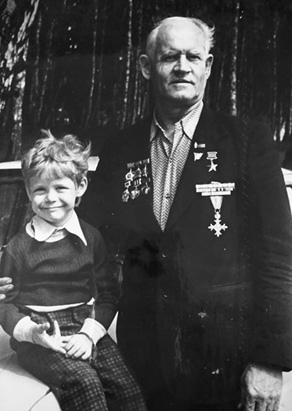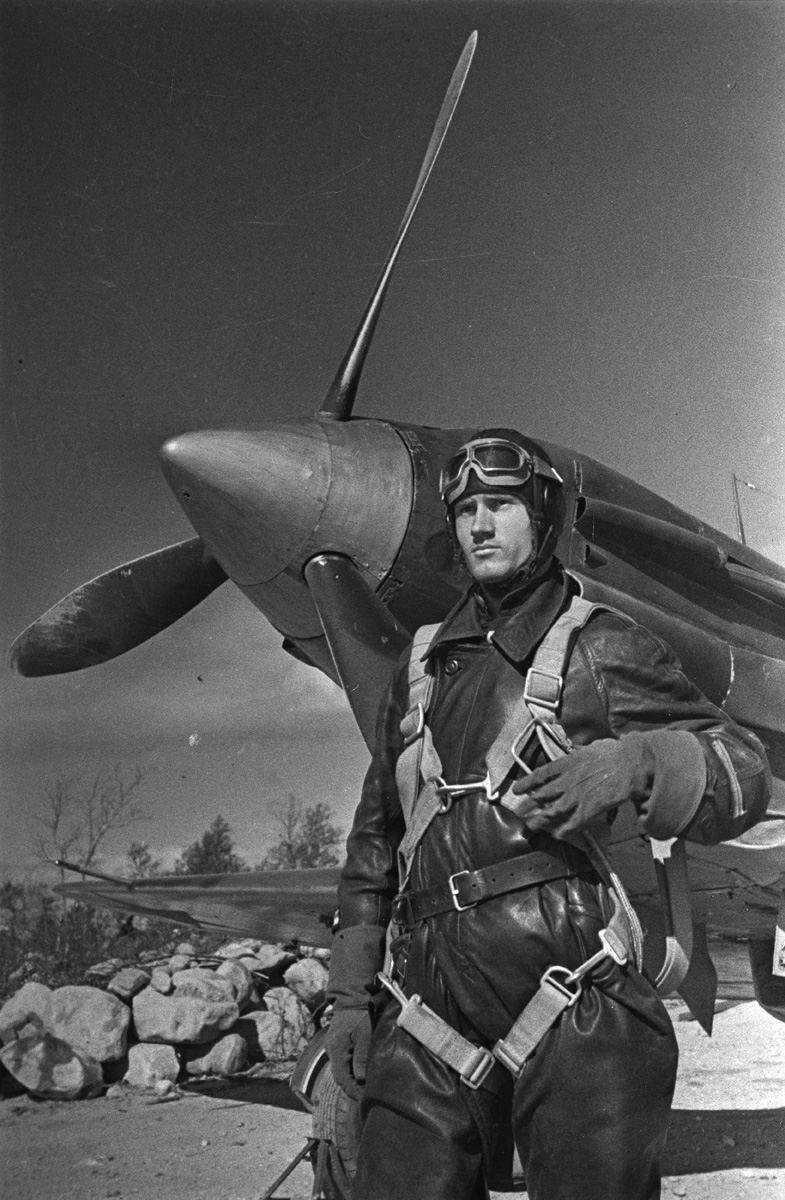Zakhar Sorokin – the Arctic’s pilot
In October 1941, the planes of Zakhar Sorokin’s squadron were put on alert in the area of Vaenga. Not long after Sorokin’s squadron was scrambled, several enemy aircraft suddenly emerged from the clouds. Almost immediately, Sorokin felt a blow to his plane and a sharp pain in his thigh: he had been wounded, and his ammunition was depleted. Below him, he spotted an enemy aircraft and quickly decided to ram it. Sorokin managed to down the enemy, but his own plane began to lose altitude, forcing him into an emergency landing on an open, icy field. His wound was troubling him. As soon as he climbed out of his plane, Sorokin was attacked by a massive, snarling dog – it was the dog of a German crew that had also landed nearby. Sorokin managed to dodge the hound and shot it dead, as well as one of the enemy pilots. Then a second German pilot, holding a Finnish knife, tried to flank Sorokin. A hand-to-hand fight ensued, and Sorokin emerged victorious, though he had once again been badly wounded – the enemy pilot had slashed him across the face with his knife. The gash ran diagonally from Sorokin’s eye to his chin. The wound in his thigh was painful, and blood was streaming down his face. He could not walk, but he had to find his comrades. Sorokin began to crawl across the ice and snow, losing consciousness and fighting through the pain and cold (by October, there was already permanent snow cover in the Arctic). After five days, locals found him – he had crawled more than 70 kilometres, suffering frostbite on both feet.
The hero of our story, Zakhar Sorokin, was born on 17th March, 1917, at the Glubokoye station in the Novosibirsk region. In the 1920s, the Safanov family moved to the city of Tikhoretsk. Zakhar Sorokin graduated from seven classes of the railway school in Tikhoretsk before going onto work as a steam locomotive assistant and simultaneously study at an aeroclub.
In 1937, Sorokin was drafted into the Red Army. He graduated from the Stalin Naval Aviation School in Yeysk in 1939. He served as a pilot in the 32nd Fighter Aviation Regiment of the Navy at the Black Sea Fleet Air Force (Sevastopol). He was there when the Great Patriotic War began. In July 1941, Sorokin was transferred to the Northern Fleet, serving in the 72nd Mixed Aviation Regiment of the Northern Fleet Air Force in a squadron commanded by the first ace of the Northern Fleet, B. F. Sorokin. Zakhar Sorokin flew a MiG-3 fighter and he scored his first triumph a few days after arriving in the North, shooting down a Me-110 fighter on 19th July, 1941. The day after this victory, Sorokin shot down a second similar fighter in an air battle while defending the Vaenga airfield. On 18th October, 1941, he was appointed deputy squadron commander. For personally shooting down five enemy aircraft, he was awarded the Order of the Red Banner on 17th September, 1941. However, he was unaware of the aforementioned fate that was to befall him in October 1941.
Following his inconceivable crawl to survival across the Arctic plains, in a hospital in Murmansk, Sorokin’s feet were amputated, and he was later evacuated to a hospital in Kirov. After 9 months of treatment, he was declared unfit for flight duty. However, Sorokin managed to secure the right to fly again after a personal audience with the Commander-in-Chief of the Soviet Navy, Admiral N. G. Kuznetsov.
In February 1943, Zakhar Sorokin returned to his regiment, which by that time had already become a Guards unit. He mastered the new Bell P-39 ‘Airacobra’ fighter, which was specially modified for him to be operated manually, and he resumed combat flights. He shot down his first enemy aircraft after returning to service (and his sixth overall) on 25th March, 1943, despite flying with prosthetics. Sorokin then participated in a legendary air battle on 19th April, 1943, during which his comrade, Junior Lieutenant N. A. Bokiy shot down the renowned German ace, Oberfeldwebel Rudolf Müller, who had been infamous for downing British planes. The Soviet command had specifically tasked their pilots with destroying the German ace.
The British military attaché, who arrived in the Arctic, awarded Sorokin the Order of the British Empire, declaring, “As long as Russia has men like him, it will be invincible.”

In the photo above Zhahar Sorokin is with the grandson of Khaldei in1976.
By July 1944, Guards Captain Z. A. Sorokin had completed 117 combat sorties (including 4 reconnaissance and 10 escort missions for torpedo bombers and bombers), he had fought in 19 aerial battles, and personally shot down 11 enemy planes – 6 of these victories whilst flying with prosthetic legs. He flew MiG-3, ‘Kittyhawk’, and ‘Airacobra’ aircraft.
On 19th August, 1944, Guards Captain Zakhar Artyomovich Sorokin was awarded the title of Hero of the Soviet Union.
In total, Zakhar Sorokin completed 267 combat missions. In June 1945, he was discharged due to illness.
He went on to write 15 books on the history of World War II.

